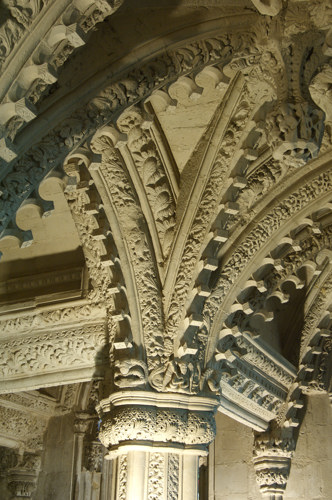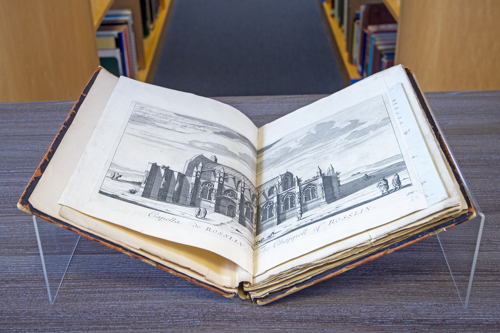An important collection recently acquired by Historic Environment Scotland (HES) will provide the public with the opportunity to find out further secrets of the world-famous Rosslyn Chapel, which has long been an inspiration for artists and writers including John Ruskin, William Wordsworth, Sir Walter Scott and most recently Dan Brown’s The Da Vinci Code.
The collection of drawings, manuscripts and engravings assembled by prominent architectural publisher and antiquarian John Britton (1771-1857), reveals contemporary thoughts from the likes of architects William Burn and George Meikle Kemp about the restoration and history of the chapel.

Rosslyn Chapel, established in 1446, is renowned for its Gothic architecture and the wealth of intricate carvings that make up its beautiful interior, which have long given rise to speculation of its association to the Knights Templar and the Holy Grail. To this day there are legends of a hidden underground crypt also discussed in the papers within this new collection.
By the 19th Century the chapel had fallen into picturesque disrepair; after succeeding as 3rd Earl of Rosslyn in 1837 James Alexander St Clair-Erskine, ordered external repairs, overseen by Edinburgh architect William Burn, with the restoration of the interior beginning in 1861 under architect David Bryce. Queen Victoria, after a visit in 1842, expressed her admiration for the chapel and her support for its preservation.
This restoration to the magnificent medieval chapel became the source of disagreement and debate, revealed in HES’s newly acquired collection, which includes evidence of correspondence between artist David Roberts and John Britton on the restoration and history of Rosslyn Chapel.
The papers also contain the views of Britton’s circle of correspondents including George Meikle Kemp, architect of the Scott Monument, and Sir Walter Scott himself, highlighting how passionately architects and artists alike felt about the building, and the regard in which Rosslyn Chapel was held.
The collection will be available for visitors to view by appointment in the Search Room of the HES Archives. HES then plan to carefully conserve and catalogue the collection, with the digitisation process taking place during 2022-23, to create a digital copy that will be available to a wider audience using the online catalogue Canmore.

The acquisition of this album was made possible with a grant from Friends of the National Libraries and the support and advice of the Rosslyn Chapel Trust.
Veronica Fraser, Acquisitions and Loans Manager at HES said:
This collection holds particular importance as it relates to one of Scotland’s most renowned and architecturally fascinating historic buildings and demonstrates how it invoked so much inspiration and strength of feeling in the past and continues to intrigue people from around the world to this day.
“HES are delighted to be able to make this wealth of information available to researchers and members of the public and we are grateful to the generosity of the Friends of the National Libraries and the support of the Rosslyn Chapel Trust to bring this material into our archives and provide people with the opportunity to find out more about this exciting chapter in the Chapel’s story.”
Ian Gardner, Director of Rosslyn Chapel Trust, said:
It’s wonderful that this important collection of papers relating to Rosslyn Chapel is now in the safe care of Historic Environment Scotland and will be available for public consultation.
“Since it was founded in 1446, the Chapel has attracted, intrigued and inspired debate amongst artists, writers and visitors, as clearly shown in this collection, and it continues to do so today.”
About Year of Stories 2022
The Year of Stories (#YS2022 #TalesOfScotland), led by VisitScotland, will be showcased throughout 2022 and will spotlight, celebrate and promote the wealth of stories inspired by, written, or created in Scotland. From icons of literature to local tales, Scotland’s Year of Stories encourages locals and visitors to experience a diversity of voices, take part in events and explore the places, people and cultures connected to all forms of our stories, past and present.
About Historic Environment Scotland (HES)
- We are the lead public body charged with caring for, protecting and promoting the historic environment. We will lead on delivering Scotland’s first strategy for the historic environment, Our Place in Time.
- Historic Scotland, Scran, Canmore, The National Collection of Aerial Photography (NCAP), The Engine Shed, Stirling Castle and Edinburgh Castle are sub-brands of HES.
- View our press pack and keep up to date by registering for media release email alerts. If you wish to unsubscribe, please contact us.
Follow Historic Environment Scotland
Twitter: @HistEnvScot | @welovehistory
Facebook: @HistoricEnvScotland | @VisitHistoricScotland
Instagram: @HistEnvScot | @historicscotland
For further information, please contact:
Zoë Carpenter
Historic Environment Scotland Media Office
Mobile: 07221 959 962
communications@hes.scot


